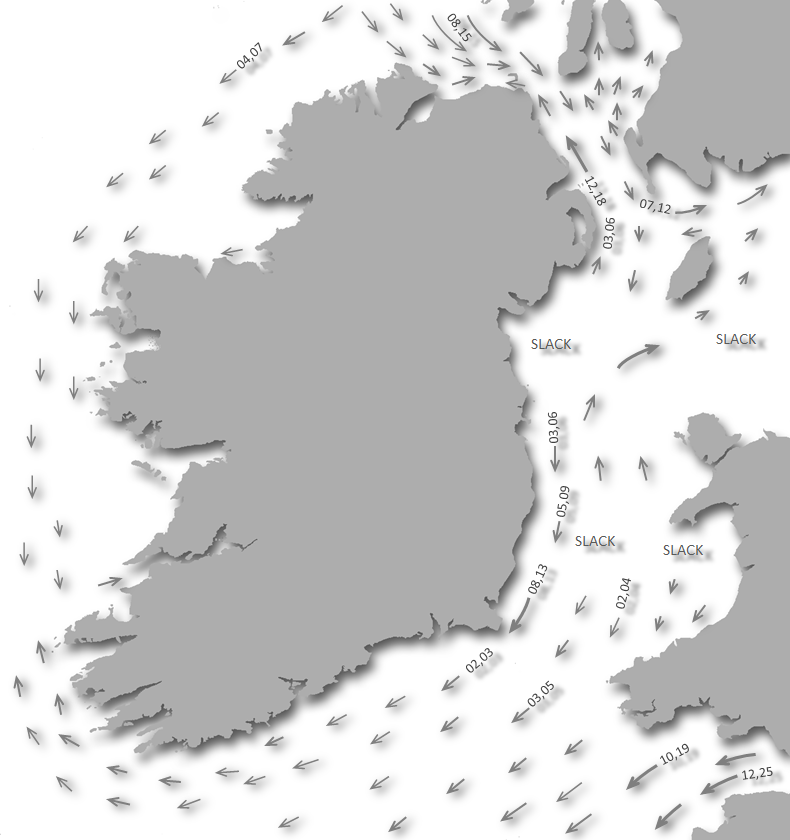
Lambay Island is a small island on the east coast of Ireland situated two miles off the coast of North County Dublin and approximately six miles north of Howth. Saltpan Bay, formerly Swallow Cove, is situated on the north side of the island close off the northwest point.
With its high sheer cliffs and deep water, making close-in anchoring possible, the secluded bay offers excellent shelter from the west through south to southeast winds. In most southerly conditions the anchorage will be found to be completely calm and free from swell. Navigation is very straightforward although daylight is required as there are no markings. Access from the north round to east is completely unimpeded, whilst approaches from other directions require basic navigation with all dangers avoided by standing off a sensible distance from the island.

Keyfacts for Saltpan Bay
Last modified
November 13th 2020 Summary* Restrictions apply
A good location with straightforward access.Facilities
None listedNature



Considerations

Position and approaches
Expand to new tab or fullscreen
Haven position
 53° 29.800' N, 006° 1.272' W
53° 29.800' N, 006° 1.272' WOn the five metre contour in the middle of the bay.
What is the initial fix?
The following Saltpan Bay initial fix will set up a final approach:
 53° 30.535' N, 006° 1.310' W
53° 30.535' N, 006° 1.310' W What are the key points of the approach?
Offshore details are available in eastern Ireland’s Coastal Overview for Strangford Lough to Dublin Bay  .
.
 .
.- Pass outside the marked dangers on the northwest and southwest corners of the island.
- Come in bearing due south to the anchorage.
Not what you need?
Click the 'Next' and 'Previous' buttons to progress through neighbouring havens in a coastal 'clockwise' or 'anti-clockwise' sequence. Below are the ten nearest havens to Saltpan Bay for your convenience.
Ten nearest havens by straight line charted distance and bearing:
- The Boat Harbour - 0.5 nautical miles WSW
- Seal Hole Bay - 0.7 nautical miles SE
- Talbot’s Bay - 0.7 nautical miles SSW
- Rush Harbour - 2.6 nautical miles NW
- Loughshinny - 3.6 nautical miles NW
- Rogerstown Inlet - 3.6 nautical miles WNW
- Malahide - 5.3 nautical miles WSW
- Carrigeen Bay - 5.8 nautical miles SSW
- Skerries Bay and Harbour - 6.1 nautical miles NNW
- Howth - 6.4 nautical miles SSW
These havens are ordered by straight line charted distance and bearing, and can be reordered by compass direction or coastal sequence:
- The Boat Harbour - 0.5 miles WSW
- Seal Hole Bay - 0.7 miles SE
- Talbot’s Bay - 0.7 miles SSW
- Rush Harbour - 2.6 miles NW
- Loughshinny - 3.6 miles NW
- Rogerstown Inlet - 3.6 miles WNW
- Malahide - 5.3 miles WSW
- Carrigeen Bay - 5.8 miles SSW
- Skerries Bay and Harbour - 6.1 miles NNW
- Howth - 6.4 miles SSW
What's the story here?
 Yacht anchored close under the cliffs in Saltpan Bay
Yacht anchored close under the cliffs in Saltpan BayImage: Servilan via CC BY 3.0
Saltpan Bay is about 500 metres east of Scotch Point the island’s northwest corner. The bay is made up of high precipitous cliffs with at least 10 metres of water to be found 200 metres off the islands northern cliffs. It has unimpeded access when approached at right angles to the shoreline or a due north approach.
With high sheer cliffs, which are home to thousands of nesting birds in season, one can anchor right up against the cliff face in Saltpan Bay's in 4 to 5 metres and listen to the raucous calls of the seabirds above.
How to get in?
 Saltpan Bay on the north side of the island
Saltpan Bay on the north side of the islandImage: Михал Орела via CC BY-SA 2.0
 Ireland’s Coastal Overview from Strangford Lough to Dublin Bay
Ireland’s Coastal Overview from Strangford Lough to Dublin Bay  provide approach details. Vessels approaching from the south can also avail of the Dublin Bay to Rosslare Harbour
provide approach details. Vessels approaching from the south can also avail of the Dublin Bay to Rosslare Harbour  coastal overview. Use the Lambay Island descriptions provided for The Boat Harbour
coastal overview. Use the Lambay Island descriptions provided for The Boat Harbour  for approaches to the island area.
for approaches to the island area. The islands outlying dangers are off its western corners that are marked by Taylor Rock north cardinal on the northwest corner and the Burren Rock starboard beacon on the southwest corner. All can be avoided by standing out a ¼ of a mile from the island.
 Yacht approaching Saltpan Bay from the northeast
Yacht approaching Saltpan Bay from the northeastImage: David Medcalf via CC BY-SA 2.0
 Vessels can anchor right up close to the cliff face in sand with very good holding in 5 metres. This said, on a sunny day however it makes sense to drop anchor a little further out from the shadow of the cliff to take benefit from the sunshine.
Vessels can anchor right up close to the cliff face in sand with very good holding in 5 metres. This said, on a sunny day however it makes sense to drop anchor a little further out from the shadow of the cliff to take benefit from the sunshine. Why visit here?
Just a short sail from the hustling, bustling capital of Ireland, Saltpan Bay is a perfect secluded escape into a nature reserve.Standing above the bay from the west is the steep sheer precipice of rock that makes it way up to Gouge Point. It plays host to the remains of a large promontory fort that dates back to Neolithic ages. Those who have been ashore say the double ditch fort’s mounds and valleys are still in a good condition and commanding views overlooking the bay and sea approaches are spectacular.
 Nesting birds in the cliffs Saltpan Bay
Nesting birds in the cliffs Saltpan Bay Image: Servilan via CC BY 3.0
The island is a very important international sanctuary for breeding seabirds. A full census of seabirds on Lambay island was completed in 2004 and it stated that... "Lambay holds Ireland's largest 'mixed' seabird colony and is of international importance". This is never so clearly appreciated than in Saltpan Bay.
The high sheer cliffs here are home to thousands of nesting birds. Vessels can anchor right up against the cliff face in deep water and listen to their raucous calls. Guillemots, gulls, puffins with their bright colourful beaks, curlews, razorbills, and Kittiwake can all be observed at close quarters nestling into the cliffs and on the surrounding water.
It is advisable for any vessel intending on stopping off here to pack a fishing rod as there is good mackerel fishing here. In local sailing circles, it is believed to pretty safe to bank upon getting a fresh dinner in Saltpan Bay.
 Yachts anchored out from the cliffs Saltpan Bay
Yachts anchored out from the cliffs Saltpan BayImage: David Medcalf via CC BY-SA 2.0
From a boating perspective, the extensive Saltpan Bay with its high protective sheer cliffs and excellent holding is perhaps one of the best anchorages on the east coast of Ireland. It makes for an ideal passage anchorage, lunch stop if you want to try your luck, or indeed a place to take refuge if it starts to blow hard from the south.
What facilities are available?
There are no facilities on the island, and no landing should take place. The island is privately owned by the Revelstoke family and the owners value their privacy. Saltpan Bay may be able provide you with a fresh supper as there is excellent mackerel fishing here.Any security concerns?
Never an issue known to have occurred anchored off this private offshore island. Vessels are most likely to be alone or in the company of other anchored yachtsmen.With thanks to:
Charlie Kavanagh - ISA/RYA Yachtmaster Instructor/Examiner.About Saltpan Bay
Just a short sail from the hustling, bustling capital of Ireland, Saltpan Bay is a perfect secluded escape into a nature reserve.
Standing above the bay from the west is the steep sheer precipice of rock that makes it way up to Gouge Point. It plays host to the remains of a large promontory fort that dates back to Neolithic ages. Those who have been ashore say the double ditch fort’s mounds and valleys are still in a good condition and commanding views overlooking the bay and sea approaches are spectacular.
 Nesting birds in the cliffs Saltpan Bay
Nesting birds in the cliffs Saltpan Bay Image: Servilan via CC BY 3.0
The island is a very important international sanctuary for breeding seabirds. A full census of seabirds on Lambay island was completed in 2004 and it stated that... "Lambay holds Ireland's largest 'mixed' seabird colony and is of international importance". This is never so clearly appreciated than in Saltpan Bay.
The high sheer cliffs here are home to thousands of nesting birds. Vessels can anchor right up against the cliff face in deep water and listen to their raucous calls. Guillemots, gulls, puffins with their bright colourful beaks, curlews, razorbills, and Kittiwake can all be observed at close quarters nestling into the cliffs and on the surrounding water.
It is advisable for any vessel intending on stopping off here to pack a fishing rod as there is good mackerel fishing here. In local sailing circles, it is believed to pretty safe to bank upon getting a fresh dinner in Saltpan Bay.
 Yachts anchored out from the cliffs Saltpan Bay
Yachts anchored out from the cliffs Saltpan BayImage: David Medcalf via CC BY-SA 2.0
From a boating perspective, the extensive Saltpan Bay with its high protective sheer cliffs and excellent holding is perhaps one of the best anchorages on the east coast of Ireland. It makes for an ideal passage anchorage, lunch stop if you want to try your luck, or indeed a place to take refuge if it starts to blow hard from the south.
Other options in this area
Click the 'Next' and 'Previous' buttons to progress through neighbouring havens in a coastal 'clockwise' or 'anti-clockwise' sequence. Alternatively here are the ten nearest havens available in picture view:
Coastal clockwise:
Seal Hole Bay - 0.4 miles SETalbot’s Bay - 0.5 miles SSW
Malahide - 3.3 miles WSW
Carrigeen Bay - 3.6 miles SSW
Howth - 3.9 miles SSW
Coastal anti-clockwise:
The Boat Harbour - 0.3 miles WSWRogerstown Inlet - 2.2 miles WNW
Rush Harbour - 1.6 miles NW
Loughshinny - 2.2 miles NW
Skerries Bay and Harbour - 3.8 miles NNW
Navigational pictures
These additional images feature in the 'How to get in' section of our detailed view for Saltpan Bay.





| Detail view | Off |
| Picture view | On |
Add your review or comment:
Please log in to leave a review of this haven.
Please note eOceanic makes no guarantee of the validity of this information, we have not visited this haven and do not have first-hand experience to qualify the data. Although the contributors are vetted by peer review as practised authorities, they are in no way, whatsoever, responsible for the accuracy of their contributions. It is essential that you thoroughly check the accuracy and suitability for your vessel of any waypoints offered in any context plus the precision of your GPS. Any data provided on this page is entirely used at your own risk and you must read our legal page if you view data on this site. Free to use sea charts courtesy of Navionics.













